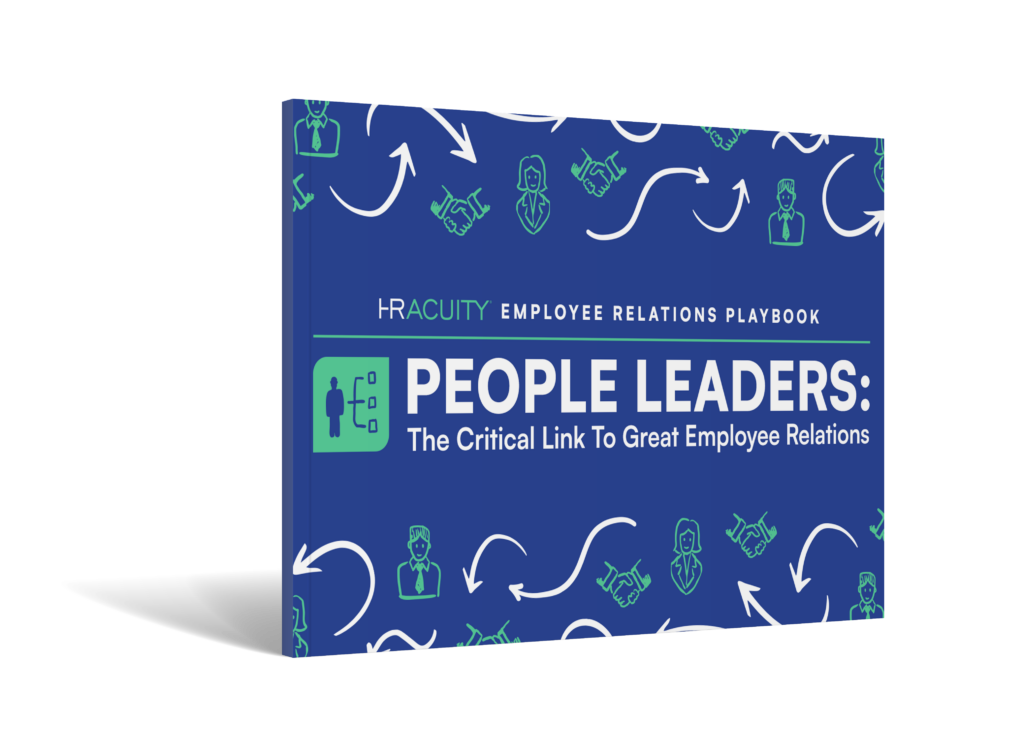Conflicts of interest can arise in any industry and at any level of an organization. Sometimes they’re obvious, but other times they can be subtle. Either way, failing to address them can erode employee trust and commitment. Plus, conflicts of interest can also damage your organization’s reputation with all kinds of stakeholders ranging from board members and employees to customers and suppliers.
Effectively managing conflicts of interest when they arise is simply smart business — and, it’s essential to maintaining strong employee relations.
In this blog, we explore best practices for addressing conflicts of interest and we highlight the benefits of using human resources (HR) and employee relations (ER) software like HR Acuity to streamline processes and promote a culture of integrity.
What Exactly Is a Conflict of Interest?
Workplace conflicts of interest occur when an employee’s personal interests interfere with their work responsibilities. This interference can take many forms, such as financial interest, extracurricular employment, personal relationships or loyalty to an external organization.
With the rise of modern technology and social media, conflicts of interest have become more nuanced and complex. Social media can blur the lines between personal and professional lives, making it difficult to separate the two.
For example, think about the countless professionals you’ll find on TikTok, such as lawyers, real estate agents, financial advisors, and fitness experts, all offering advice and promoting courses. Are they breaking the law? Not at all; they’re simply building their personal brand. But should this be a cause for concern? Well, it depends.
If an employee’s side hustle could potentially harm your organization or tarnish its reputation, it’s definitely worth investigating. Offering advice on social media is much different than a more extreme example of a conflict of interest – like a rental car company employee stealing cars and selling their parts at a chop shop (yes, it happened.) It’s crucial to recognize the varying degrees of conflicts of interest and address them accordingly.
While conflicts of interest can be challenging to identify, there are a few common sense questions you can ask to determine if a conflict exists:
- Does the employee or their family stand to gain financially from a specific decision made in their professional capacity?
- Are they promoting an external interest or item that competes with those sold by their employer?
- Is it possible that company resources are being utilized for personal goals? (This one is tricky, professional experience gained over years belongs to an employee, as long as they aren’t using proprietary information that is supposed to remain confidential.)
Examples of conflicts of interest in the workplace include:
- Hiring a family member for a position within the company (known as nepotism). While under most circumstances hiring a family member isn’t illegal, it can open the organization up to discrimination suits if a better qualified employee is overlooked for a role.
- Investing in a competing business. This one is pretty obvious. Employees or leaders having a financial interest in a competitor’s performance will almost certainly influence and/or harm decision making within the organization.
- Selling or buying stock in a company based on insider information you discovered from within your place of employment. This one is both obvious and illegal.
- Accepting gifts from vendors in exchange for preferential treatment. In some industries, like the pharmaceutical industry, the rules around vendor gifts are very clear. However, for many industries, this conflict of interest can be very nuanced. For this reason, it’s wise to have very clear policies that are consistently communicated to employees who are in a position to be ‘courted.’
- Taking on a second job with a competitor or choosing to work with a client separate from the employer. The ubiquity of remote work made multi-job-tasking much easier to pull off in recent years. Jobs with more autonomy such as software developers and project consultants fueled this trend during the pandemic. While individual state laws handle this differently, generally at-will employment makes having multiple jobs legal. Again, this is why having crystal clear policies stated up front is important.
- Using company resources to conduct research for a personal project without authorization. This is another tricky one. Remote work makes it hard to spot this and even harder to prove it. If the main issue is the loss of employee productivity due to time spent on a personal project, consider repositioning this as an opportunity for self development. Offer employees approved times when they are encouraged to work on personal projects. If the issue is that they are squandering expensive resources, make sure you are clearly articulating and communicating your policies and subsequent consequences around personal use of company resources.
Even the perception of a conflict of interest can create a problem and should be handled by HR and ER professionals. If you’re unsure whether an employee’s intent can lead to a perceived conflict, the right move is to proceed in the same way you would investigate an actual conflict.
Conflicts of interest breed a number of concerns for employers, including a loss of trust among employees and clients, damage to the company’s reputation and both legal and financial consequences. It’s essential for employee relations teams to identify and address conflicts of interest as soon as they are aware of them.
Read our Employee Relations Playbook
Train people leaders to better manage employee issues.

Best Practices for Addressing Conflict of Interest at Work
The following best practices can help your team establish a culture of integrity and mitigate the risks associated with conflicts of interest.
Establish clear policies and procedures
Your organization should have clear processes, policies and procedures in place to handle conflicts of interest. Your team should outline and communicate what constitutes a conflict of interest, how employees should disclose potential conflicts and what steps the organization will take to solve them.
Choose the correct conflict management style
There are multiple methods for approaching conflict. It’s imperative to choose the right style to match each situation’s requirements and severity. Remember, some conflicts may not be intentional, and it’s your job to help the employee understand why there is an issue and whether it can be easily resolved.
Encourage disclosure
Employee relations teams should regularly encourage employees to disclose any personal relationships or financial interests that could impact their work. This can be done through training sessions, regular reminders and providing a safe and confidential mechanism for reporting.
It’s worthwhile to note that managers may have grounds to terminate a worker who refuses to disclose a conflict of interest. This may be because the worker engages in behavior that violates the organization’s policy.
Evaluate potential conflicts fairly and consistently
When an employee brings up a potential conflict, it’s crucial to take a step back and assess the situation with an unbiased perspective. Evaluate the severity of the conflict and its possible impact on the organization, keeping in mind that fairness and consistency are key.
It’s important to treat every case with the same level of scrutiny, regardless of the individual’s role within the organization. If your company strictly enforces conflict of interest policies for lower-level employees but turns a blind eye when it comes to people in leadership roles, trust and integrity within the workplace will suffer even more.
Develop a mitigation plan
Develop a plan to mitigate any potential conflicts. Again, the plan needs to match the intent. If the conflict is accidental, mitigation plans may include simply modifying the employee’s responsibilities. On the other hand, if the conflict is intentional, the mitigation plan may require them to divest from certain investments or prohibit them from engaging in specific activities.
Monitor compliance
The compliance implications of conflicts of interest can be significant, particularly in regulated industries that are held to a high standard by applicable laws and regulations, such as finance, healthcare and public and government services. Conflict of interest policies and procedures must be continuously monitored for possible compliance issues through regular audits, spot-checks and periodic training sessions.
Review the employee handbook
Update the organization’s conflict of interest policy on a regular basis. All staff should get the chance to read the employee handbook in its entirety and sign a document stating that they have done so. This must also be done with each amendment or modification that is made. Not only will this be useful in the event of a dispute, but it keeps employees informed of what their employer considers a conflict of interest.
Create a culture of integrity
Ethical behavior should be encouraged and rewarded through regular communication, training and by setting an example from the top down. When honorable conduct is awarded, it’s more likely to be imitated by others.
When it comes to romantic relationships in the workplace, most companies will prohibit associations between employees who have a direct or indirect reporting relationship. In cases where a romantic relationship does exist, employee relations should evaluate the situation to determine if a true conflict of interest occurred.
See HR Acuity's Solutions in Action
Discover why HR Acuity is the preferred employee relations management software.
Handling Potential Conflict With Employee Relations Software
In recent years, employee relations software has become an increasingly popular tool for companies looking to manage employees effectively and address and prevent conflicts of interest in the workplace. These solutions can help HR and ER departments to identify potential conflicts of interest, track disclosure forms and ensure compliance with relevant laws.
The increasing complexity of employment regulations, the need for more efficient HR processes and the rising importance of ethical conduct in the workplace are all reasons why we have seen so much growth in the use of ER software.
HR Acuity can help streamline the process of identifying and addressing conflicts of interest. Software can be used to evaluate probable conflicts and develop mitigation plans, reducing the risk of negative consequences for employees and the organization.
In addition to helping with conflict of interest management, employee relations software can also help to promote ethical conduct in the workplace. By providing a clear and consistent framework for reporting and addressing potential conflicts, our software can contribute to a more honest workplace culture – something that’s crucial in a modern business environment.



